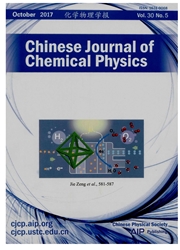

 中文摘要:
中文摘要:
本文设计了一种起皱模型用以研究起皱现象的动态过程.模拟表明整个起皱过程包括三个阶段.在孵化和起皱阶段,水平方向上软基底的应力在回缩过程中传递给硬膜.而在构象松弛平衡阶段,硬膜上的应力又缓慢地传回给软基底,整个起皱过程体系的总能量持续下降.研究发现起皱后软基底上的应力集中在上表层,尤其是在波谷处.而硬膜上的应力分布则取决于方向,在垂直方向,平衡位置的应力要大予波峰和波谷处,与此相反,在水平方向应力则更集中于波峰和波谷.我们的模型既能重现起皱现象,又能重现起皮现象,为材料应力释放导致的结构失稳机理研究提供了一个非常有利的工具.
 英文摘要:
英文摘要:
Numerous theoretical and experimental efforts have been made to explain the dependence of the static wrink~h~g morphology on the materials' physical properties, whereas the dy- namic wrinkling process remains elusive. In the present work, we design a wrinkling model consisting of a soft substrate and a graphene-like rigid thin film to investigate this dynamic process. The simulation shows that the whole wrinkling process includes three stages. At the incubation and wrinkling stages, the stress along the horizon direction of the soft substrate transfers to the stiff film. However, at the equilibrium stage, the stress of the rigid film slowly transfers back to the substrate although the total energy still decreases. It is found that the stress of the substrate concentrates at the top surface, especially at the trough, whereas the stress distribution of the film depends on direction. In the perpendicular direc- tion, the stress at the wave's equilibrium position surpasses that at the crest and trough and, oppositely, the stress concentrates at the crest and trough in the horizon direction. Present model reproduces both wrinkling and delamination patterns and can be a powerful tool to deeply understand the structure deformation of material induced by stress release.
 同期刊论文项目
同期刊论文项目
 同项目期刊论文
同项目期刊论文
 DISSIPATIVE PARTICLE DYNAMICS SIMULATION ON THE EFFECT OF LINE TENSION ON BENDING RIGIDITY OF BILAYE
DISSIPATIVE PARTICLE DYNAMICS SIMULATION ON THE EFFECT OF LINE TENSION ON BENDING RIGIDITY OF BILAYE Microfluidic fabrication and thermoreversible response of core/shell photonic crystalline microspher
Microfluidic fabrication and thermoreversible response of core/shell photonic crystalline microspher Thermodynamic and conformational insights into the phase transition of a single flexible homopolymer
Thermodynamic and conformational insights into the phase transition of a single flexible homopolymer Structural Transformation of Diblock Copolymer/Homopolymer Assemblies by Tuning Cylindrical Confinem
Structural Transformation of Diblock Copolymer/Homopolymer Assemblies by Tuning Cylindrical Confinem Reaction Kinetics of Nonideal Hyperbranched Polymerizations: Influences of Chain Rigidity and Reacti
Reaction Kinetics of Nonideal Hyperbranched Polymerizations: Influences of Chain Rigidity and Reacti Kinetics of multicompartment micelle formation by self-assembly of ABC miktoarm star terpolymer in d
Kinetics of multicompartment micelle formation by self-assembly of ABC miktoarm star terpolymer in d Computer simulation of the formation of anti-fouling polymeric ultrafiltration membranes with the ad
Computer simulation of the formation of anti-fouling polymeric ultrafiltration membranes with the ad ABC triblock copolymer particles with tunable shape and internal structure through 3D confined assem
ABC triblock copolymer particles with tunable shape and internal structure through 3D confined assem Melting processes of oligomeric alpha and beta isotactic polypropylene crystals at ultrafast heating
Melting processes of oligomeric alpha and beta isotactic polypropylene crystals at ultrafast heating A coarse-grained molecular dynamics - reactive Monte Carlo approach to simulate hyperbranched polyco
A coarse-grained molecular dynamics - reactive Monte Carlo approach to simulate hyperbranched polyco Self-assembly of Janus ellipsoids: a Brownian dynamics simulation with a quantitative nonspherical-p
Self-assembly of Janus ellipsoids: a Brownian dynamics simulation with a quantitative nonspherical-p Adsorption of polyethylenimine and its interaction with a genomic DNA on a silicon oxynitride surfac
Adsorption of polyethylenimine and its interaction with a genomic DNA on a silicon oxynitride surfac Enhancing the efficiency of lithium intercalation in carbon nanotube bundles using surface functiona
Enhancing the efficiency of lithium intercalation in carbon nanotube bundles using surface functiona Encapsulation of inorganic nanoparticles into block copolymer micellar aggregates: Strategies and pr
Encapsulation of inorganic nanoparticles into block copolymer micellar aggregates: Strategies and pr A smart DNA-gold nanoparticle probe for detecting single-base changes on the platform of a quartz cr
A smart DNA-gold nanoparticle probe for detecting single-base changes on the platform of a quartz cr DNA Polymer Brush Patterning through Photocontrollable Surface-Initiated DNA Hybridization Chain Rea
DNA Polymer Brush Patterning through Photocontrollable Surface-Initiated DNA Hybridization Chain Rea 期刊信息
期刊信息
